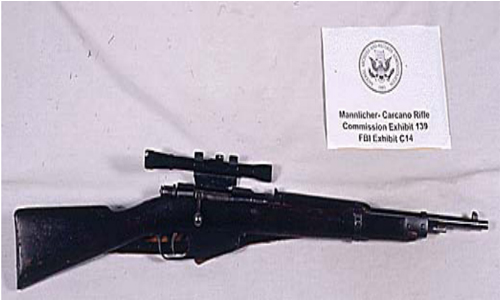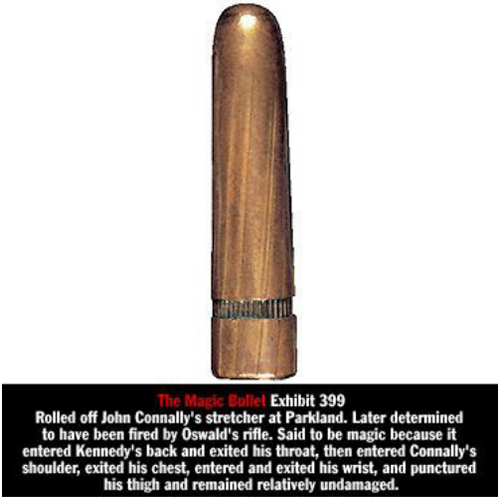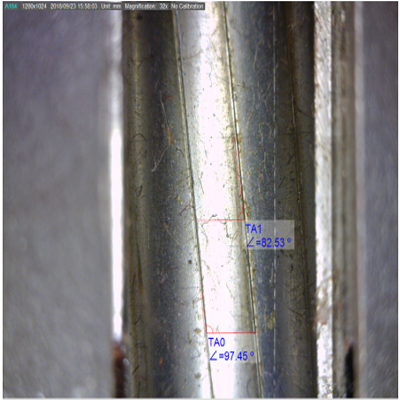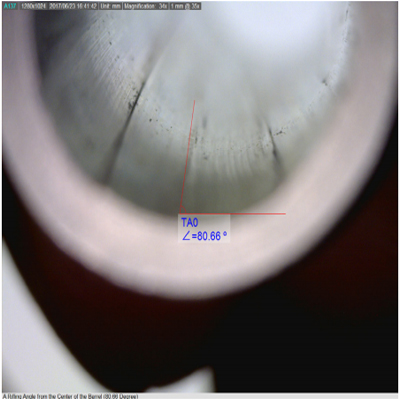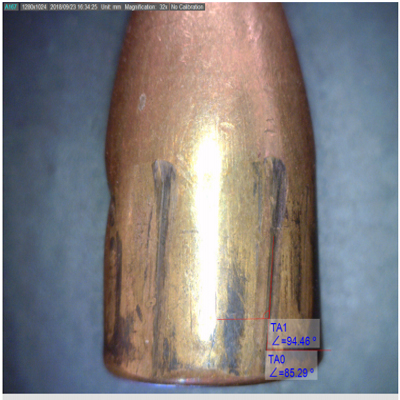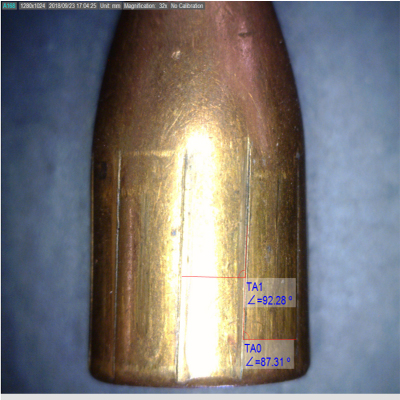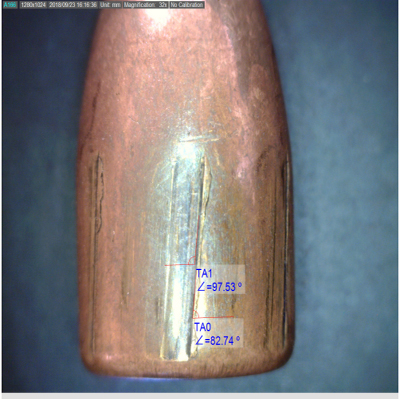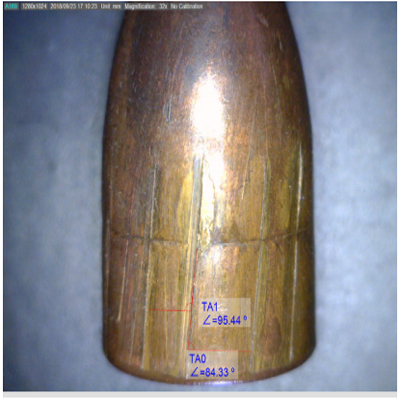Previous Issues Volume 1, Issue 1 - 2018
Real Time and In Situ Measurement of Rifling Angles with a Hand-Held Digital Device: A Technical Implication to the JFK Assassination Case
John Zheng Wang*
Forensic Studies Program, School of Criminology, Criminal Justice, and Emergency Management, California State UniversityLong Beach
Corresponding Author: John Zheng Wang, Forensic Studies Program, School of Criminology, Criminal Justice, and Emergency Management, California State University-Long Beach, Tel: 562-985-4741; E-Mail: [email protected]
Received Date: 26 Sep 2018 Accepted Date: 08 Oct 2018 Published Date: 1 1 Oct 2018
Copyright © 2018 Wang JZ
Citation: Wang JZ. (2018). Real Time and In-Situ Measurement of Rifling Angles with a Hand-Held Digital Device: A Technical Implication to the J.F.K. Assassination Case. Mathews J Foren. 1(1): 005.
ABSTRACT
November 22, 2018, marks the 55th anniversary of the assassination of President John F. Kennedy, one of the most traumatic murders in U.S. history. Two official investigations were conducted by the Warren Commission's Report in 1964 and the House Select Committee on Assassinations' Report in 1979. Several scientific studies have also been conducted to find the truth about the murder. However, none of the studies has focused on the rifling angle comparison between the alleged murder weapon (CE 139) and the nearly intact bullet (CE 399). Although the bullet was the only useable physical evidence found on Governor Connally's stretcher, the bullet and the rifle have not been used in any forensic examinations, mainly because these two pieces of evidence are the protected items under the National Archives. Via a quasi-experimental test, this study introduces a new hand-held device that can measure and compare the rifling angles inside a gun barrel and on the surface of a bullet. This device provides unique examination features: real-time image, digital measurement, and in situ measuring position, thus non-destructive, non-contact, and quantifiable. The testing results indicate that the rifling angle comparison may suggest a new examination direction to determine if the CE 399 was actually fired by the CE 139.
KEYWORDS
J.F.K. Assassination; Firearms Examination; Rifling; Rifling Angle; Lands and Grooves; Bullet-Weapon Correlation; Rifling Twist; Rifling Pitch; Quantitative Forensics.
INTRODUCTION
The year of 2018 marks the 55th anniversary of the assassination of the 35th United States President, John F. Kennedy, Jr. However, the assassination remains a mystery in three lines of inquiries. First, the Warren Commission's Report that was released on September 27, 1964, concluded that Lee Harvey Oswald fired three shots from a rifle (See Figure 1) that killed Kennedy and injured Connally from a sixth-floor window in the Texas School Book Depository. Some critics of the report from other ballistics experts' conclusions and a home movie film aiming at the scene challenged the theory that three bullets from a rifle that could have caused Kennedy's fatal wounds as well as the injuries to the Texas governor, Connally [1]. Second, the U.S. House of Representatives Select Committee on Assassinations (HSCA) launched a new investigation into President Kennedy's death. In its final report in 1979, the Committee agreed partially with the Warren Commission's findings that two bullets fired by Oswald had killed Kennedy and wounded Connally. However, the HSCA's Report also concluded that there was a high probability that a second gunman fired at Kennedy, and that the President was probably assassinated because of an unspecified conspiracy [2]. Finally, despite its seemingly firm conclusions from the two reports, the contents of the two documents seem to promote more controversies and have not been able to silence the conspiracy theories surrounding the assassination. Subsequent investigations as well as some research projects have shown different results and called to question the two reports.
Figure 1: The murder weapon determined by the Warren Commission's Report (Image Source: Downloaded from Google Images).
On April 26, 2017, the National Archives released 19,045 additional documents from the JFK assassination files. On October 26, 2017, about 3,000 never-before-seen documents were released from the National Archives. Although the 25- year deadline established by the 1992 JFK Records Collection Act has expired, the release of the final remaining classified files was delayed for an additional six months. In December 2017, the National Archives claimed that only 86 records remained. Now that deadline has passed, and it is unclear how many records (or portions of the records) remain, and whether they will ever be ever released in full, and if there is any new information they may contain.
CASE REVIEWED
Between 11:50 am and 12:30 pm on November 22, 1963, President Kennedy's limousine was approaching the intersection of Houston and Elm Streets in Dallas, Texas and then passing a seven-story, orange brick warehouse and an office building, the Texas School Book Depository. Inside the President's motorcade, Mrs. Kennedy was sitting to the left of the President in the rear seat, Governor Connally was sitting in front of the President in the jump seat, and Mrs. Connally was on his husband's left. Secrete Service Agent William Greener was driving at about 11 miles per hour, and Agent Roy Kellerman was sitting to his right [3].
Gunshot Wounds to President Kennedy At approximately 12:30 pm, a rapid succession of gunshots were heard. From an amateur's 35 mm film recorded by Abraham Zapruder, President Kennedy moved his two hands to his neck, his body then turned to stiffen for a moment, and finally leaned forward to the seat. Based on the autopsy report, a bullet entered the base of his neck slightly to the right of his spine. The bullet continued to pass downward and exited in the front of the neck, causing a nick in the left lower portion of the knot in the President's necktie. Another bullet then struck President Kennedy in the rear portion of his head, which was the fatal shot and produced a massive wound [1].
Gunshot Wounds to Governor Connally From the same film, Governor Connally is seen starting to turn toward the left and suddenly felt a blow to his neck. He was hit by a bullet, which entered at the extreme right side of his back at a point below his right armpit. The bullet then passed through his chest in a downward first and then forward direction, and finally exited below his right nipple. Strangely, the bullet continued to pass through his right wrist, which has laid on his lap and caused a wound to his left thigh [1].
Four Conclusions from the Warren Commission's Report Based on the Warren Commission's Report, four conclusions can be summarized here: (1) Lee Harvey Oswald killed President Kennedy alone and the conclusion was based on scientific evidence and through modern technology available at the time. "The shots which killed President Kennedy and wounded Governor Connally were fired by Lee Harvey Oswald." (2) Although the eyewitness reports were conflicting, the Commission concluded that three shots were fired because three spent cartridges fired by the rifle were found on the sixth floor of the Texas School Book Depository Building. (3) One shot passed through President Kennedy's neck and then "most probably" passed through the chest of Texas Governor John B. Connally Jr. A subsequent shot or the fatal one hit the back of the President's head. Another shot probably missed the Presidential limousine and its occupants altogether. (4) However, two major questions are left unanswered by the Warren Commission's Report: Which of the three shots, No.1, No. 2, or No. 3, killed the President? Which shot was the missed shot, the first, second or third shot?
Four Major Pieces of Original Physical Evidence The Warren Commission's Report indicated the following four major pieces of physical evidence obtained from the murder incident: (1) The rifle (CE 139 with the serial number C2766) was found on the sixth floor. (2) Three fired cartridges were found on the sixth floor. (3) Two relatively large bullet fragments were found in the Presidential limousine. They are CE 567 (Q2) of a bullet fragment from the seat cushion (lead core plus brass jacket, 2,890 milligrams) and CE 569 (Q3) of a bullet fragment from the front seat (jacket, 1,361 milligrams). (4) A nearly whole bullet (CE 399) was discovered almost by accident when a hospital engineer bumped into Governor Connally's stretcher.
PREVIOUS RESEARCH AND EXAMINATION
Due to many unanswered questions and some unexplained circumstances, several scientific studies have been conducted and suggested for different hypotheses or conclusions.
THE X-RAY STUDY
Mantic conducted an X-ray examination on the mysterious 6.5 mm object that was not in the official autopsy on November 22, 1963 [4]. Strangely, the X-ray image first appeared in the historical record in 1968 with the release of the Clark Panel Report, which showed that a 6.5 mm object lies within JFK's right orbit on the skull X-ray. His study explained and demonstrated that X-ray alteration was feasible in 1963, suggesting a candidate for possible darkroom work. Mantic made hundreds of optical density data points to expose the paradoxes of the 6.5 mm image. Also, the phantom image (of an authentic bullet fragment), seen as a 6.5 mm object, is consistent with double exposure in the X-ray darkroom. Finally, he made three conclusions: (1) The mysterious 6.5 mm image was (secretly) added to the original X-ray via a second exposure. (2) The alteration of the X-ray was likely completed shortly after the autopsy. (3) Its proximate purpose was to implicate Lee Harvey Oswald and his supposed 6.5 mm Mannlicher-Carcano carbine rifle (See Figure 1) as the lone assassin and the only murder weapon to exclude any other suspect, and thereby to rule out a possible conspiracy. However, the study did not specifically explain the differences in image quality between a second exposure and an accidental or purposeful overlay.
The Chemical Composition Study Spiegelman and his colleagues conducted a chemical test using a new compositional analysis of the bullets against the bullet fragments from the case [5]. They stated that although the ammunition (Mannlicher-Carcanos, 6.5 mm) was only produced in 1954 in Italy (See Figure 2), the researchers were able to purchase some ammunition from the same batch. Thus, the ammunition was not as rare as the media had reported. The researchers analyzed the composition of 30 bullets, ten from each of three boxes of Mannlicher-Carcano ammunition that originated from two of the only four separate lots ever produced. Using the additional chemical elements, quality control procedure, and the physical samples with a known geometry not available in the 1960s, they determined that many bullets within a box of Mannlicher-Carcano ammunition (bullets) have a similar composition. As a result, they concluded that two-element comparison matches the fragments from the assassination are not extraordinarily rare. This conclusion was contradicted by the finding described in the HSCA Report that the five fragments came from the same box from one rifle and one shooter. In other words, if one of ten test bullets from one box analyzed is considered a match to one or more of the five existing evidential fragments from the scene, the matching fragments, therefore, could have come from three or more separate bullets. Accordingly, their findings suggest that there may be more than one shooter because the suspected assassin Oswald only fired three shot at most. However, the study did not specify which location/source their five fragments came from. There were five locations or sources for the bullet fragments: (1) CE 567 (Q2): Bullet fragment from the seat cushion (lead core plus brass jacket). (2) CE 569 (Q3): Bullet fragment from the front seat (jacket). (3) CE 843 (Q4,5): Two lead fragments from the President's head. (4) CE 842 (Q9): Three lead fragments from the Connally's arm. (5) CE 840 (Q14): Three lead fragments from the rear carpet. Further, at least ten bullet fragments from the five sources were found as evidential items, although the actual pieces of fragments spilt from Q9 remained uncertain.
Figure 2: The only intact bullet found from Governor's stretcher, which was determined by the Warren Commission's Report to be one of the three bullets fired by Oswald (Image Source: Downloaded from Google Images).
In 2004, however, a report from the National Research Council [6] recommended to discontinuing the examination method due to the other study results: Copper, arsenic, tin, and/ or antimony by the analytical chemistry examination do not show a systematic consistency in each batch of cartridges (bullets) by manufacturer. On the contrary, there are too many variations in the bullet manufacture processes. The report suggested that the comparison between the gunshot residues on the surfaces from both JFK, the governor, and the leftover cartridges in the rifle should not be valid.
THE ACOUSTIC STUDY
Thomas conducted an acoustic study and pointed out that there may indeed have been a fourth shot from the legendary Grassy Knoll area that killed President JFK [7]. According to the microphone recording from one of the motorcycle police officers, a gunshot-like sound occurred to the right of the motorcade and exactly at the same time when the president was shot. The study analyzed the recordings made on two police channels on the day of the assassination in 1963. One was recorded when a motorcycle police officer in the president's motorcade inadvertently left a microphone on his vehicle switched on. The analysis of this channel later revealed a gunshot-like sound coming from the region of the grassy knoll. The second channel recorded routine transmissions from the lead car in the motorcade that was driven directly in front of the President's limousine. Thomas concluded that there is a 96 percent likelihood that a fourth shot was fired from the Grassy Knoll area because the gunshot-like sounds occur exactly synchronous with the time of the shooting. Although the recordings provided original sound evidence, Thomas' study did not conduct an experiment to differentiate between a sound of a gunshot and common noise produced by a motorcycle manufactured in the 1960s.
THE KINETIC ENERGY STUDY
Based on approximately eight second 35 mm film recorded by cameraman Abraham Zapruder, Nalli analyzed the images, which show a fatal gunshot impact to the President's head [8]. The accompanying backward motion of the President's head after the bullet impact appeared first to support later "conspiracy theories," which claimed that it was the proof of a shot from the front (in addition to one from behind). Nalli employed a simple one-dimensional dynamical model and the motion of the President's head observed in the film. Using known parameters from the crime scene, explicit force calculations are carried out for determining the projectile's retardation during the tissue passage along with the resulting transferring momentum by the principle of kinetic energy response (KE). The computed instantaneous KE transfer within the soft tissue is found to be consistent with the formation of a temporary cavity associated with the observed explosion of the head, and subsequent quantitative examination of this phenomenon revealed two delayed forces at play in the backward motion of the President following the bullet impact. Therefore, it is found that the observed motions of President Kennedy in the film are physically consistent with a high-speed projectile impact from the rear of the motorcade, which resulted from an instantaneous forward impulse force, followed by delayed rearward recoil and neuromuscular forces. However, the quantitative examination ignored another important factor: a sudden vehicular speed-up by the driver after he heard the first gunshot, which may have caused President Kennedy's sudden backward movement or what is called "rearward jerk."
MATERIALS AND METHODS
Research Design From a forensic examination perspective, three key questions remain unanswered: (1) Which bullet actually killed President Kennedy? (2) What is the sequential order of the three shots? (3) Was there a fourth bullet? While the three questions seem more difficult to conduct any research projects before the complete release of the documents, this study raises a more realistic question, which has been ignored so far: Was the bullet (CE 399) found on Governor Connally's stretcher actually fired by the alleged rifle (CE 139)?
The two official investigating bodies did not specify whether they conducted any test fires using the evidence (the rifle/ the Exhibit 139) probably for three reasons. First, the rifle has become a valuable exhibition in the JFK National Museum, meaning no one can touch the rifle (the Exhibit 139). Second, the rifle may be altered or even damaged by a test fire, which could be a destructive test due to the uncertainty of the firing mechanism. Third, a non-destructive method simply did not exist during this time. A reexamination requires a device to conduct a non-destructive examination by real-time and in an in-situ method to maintain the integrity of the original evidence.
The purpose of this research project is to employ a new digital device that can measure the rifling angle inside a gun barrel and the rifling angle on a bullet for comparison. It is hoped that if the test is successful, scientific, and practical, a technical implication then should be recommended to further studies and examinations of the JFK case.
The rifling inside a barrel is made of lands (the uncut portion) and grooves (the cut portion) when the barrel is rifled in a twisted pattern. When fired, the bullet is forced to enter into the rifled barrel and start spinning in the barrel. The purpose of rifling is to make the bullet further spin in the air in a more stable manner (not tumbling or wobbling) and to a longer distance because the spinning (from the 6 o’clock position to the 12 o’clock position) produces a circular momentum that cancels the gravity.
Current Examination Criteria The traditional bullet-weapon examination focuses on the following identification criteria for a matching: (1) The caliber specific, (2) the direction of rifling, (3) the number of rifling, (4) the width of rifling, and (5) the number of striations. These criteria require a test fire of the weapon (the rifle) involved, which is unfeasible in the JFK case due to the reasons mentioned above. In theory, the twisted rifling (lands and grooves) inside a barrel has a fixed angle, thus can be used to determine if a bullet is fired by a particular weapon as an additional identification criterion. Assuming the above five identification criteria have been used by the firearms examiners for the Warren Commission's Report, this study proposes a new examination approach: compare the rifling angle between the rifle and the bullet via a portable digital device. If successful, the device and the method may suggest a technical implication to the two important pieces of evidence: the rifle (CE 139) and the bullet (CE 399).
Mechanical Concepts Once the research design is determined, several mechanical concepts should be discussed: (1) Spinning: When the bullet is forced into the chamber, the throat and finally into the barrel, the bullet starts engaging the rifling or spinning due to the engraved grooves in the barrel. (2) Pitch: A pitch is a distance the rifling makes a complete turn in a single revolution, e.g., one turn in 12 inches, thus also called rate of twist. The longer the barrel is, the slower the twist revolves. However, due to limited technology at present, the pitch is not being used in firearms examination because it is very difficult to measure the pitch practically. (3) Rifling Angle: Although the pitch has limited use in firearms examinations, the term does provide another useful indicator: the rifling angle at which the rifling is cut in the barrel. The rifling angle can be used to determine at least if two bullets are not fired from the same gun (exclusion). When two fired bullets are placed side by side in a vertical position, one can compare the degree of the slants of the rifling lines by the rifling angle. Therefore, expanding on the same principle, if the rifling angle inside a barrel can be measured and compared with the rifling angle on the bullet, then this may be a new direction to determine if a bullet was fired from a particular weapon.
Two Recent Reports In 2009, the National Research Council issued a report (often referred to as the NRC Report) and challenged that current forensic methods, except for nuclear DNA analysis, are less reliable and consistent to identify a specific individual or source due to a lack of quantifiable measurements [9]. In 2016, The President's Council of Advisors on Science and Technology (also known as the PCAST Report) recommended further actions to strengthen forensic science and promote its more rigorous use in the courtroom, again challenging that pattern-matching forensic procedures are less scientific due to its lack of standardization and computerization [10]. While the two reports have received mixed feedbacks and responses, a quantifiable and computer standardization seems to be the future direction for the forensic science community.
RESEARCH HYPOTHESIS
Based on the authors' two previous research projects [11, 12], the current research hypothesis states: If the rifling angle inside the barrel is measured at 87o , which is different from the rifling angle on the bullet measured at 84o ), then an exclusion conclusion can be reached with much higher certainty than if the two bullets were not fired by the same weapon, simply because every barrel has a unique rifling angle.
Data Collection Purposive sampling was employed to conduct the quasiexperimental test, focusing on an evidence-based, field-driven, and quantifiable measurement approach, an experience obtained from the author's previous project [13].
Black Box Sampling was also employed due to the difficulties in obtaining a pair of rifles and its fired ammunition, two 9 mm pistols were obtained for this study. The steps are stated as follow:
- Pistol A was used to fire one bullet into three telephone books for an intact bullet and the fired bullet was mixed with three other fired bullets (also intact, 9 mm), which were collected from a local gun-store owner by the author's research assistant. The labeling of Bullet A, B, C, and D was unknown to the author of this paper to follow the principle of the Black Box Study in which the examiner has no knowledge of the sources of the samples for a blind review study to reduce the cognitive bias.
- After the firing, Pistol A's barrel was cut into half for measuring its rifling angle using the digital device. The purpose of cutting the barrel is to have a control sample.
- After the cutting, Pistol A's barrel was measured by its rifling angle horizontally using the digital device.
- Pistol B did not fire any bullet, but was measured by its rifling angle using the digital device.
Control Sample Pistol A's barrel was cut into half for three reasons: (1) It serves as a control sample. (2) The rifling angle could be measured vertically by the digital device, which was different from the measurement of Pistol B. (3) The cut-half barrel was measured again manually of its rifling angle to verify the accuracy of the digital device. The aim was that the control sample of the cuthalf barrel would minimize the Type I Error (false negative) as well as the Type II Error (false positive) to achieve a relative ground truth.
RESULTS OF THE QUASI-EXPERIMENTAL TEST
To a simulate the positions where the two exhibits (CE 139 and CE 399) are being displayed, the author employed a quasiexperimental test to measure both the two barrels (Pistol A and Pistol B) and the four fired bullets in an in situ manner, which was in a minimum-contact and non-destructive method with quantifiable digital images.
With the quasi-experimental design, the cut-half barrel from Pistol A was measured from a vertical position (top-down) using the digital device at a magnification of X 32 for the best focus and a working distance of 44 mm (See Figure 3). Two angles were achieved with the interior angle of 82.53o (the smaller angle) and the exterior angle of 97.45o (the larger angle). The sum of the two angles is 179.98o with an error of .02, thus meeting the semicircle theorem: Interior Angle + Exterior Angle =180o. For the sake of consistency with the latter rifling angles from the four bullets, the interior angle was used as the rifling angle for comparison. The two angles were verified manually with a semicircle ruler for 82.50o and 97.50o.
Figure 3: The digital measurements from the inside of Pistol A were acquired for the interior angle (the rifling angle) of 82.53o and the xterior angle of 97.45o.
The digital device was then adjusted aiming against the muzzle of Pistol B (almost touch) horizontally to measure the rifling angle inside the barrel, assuming the pistol were being displayed in the same exhibit position that CE 139 was being displayed. The magnification is set at X 34 for the best focus (See Figure 4) and the rifling angle is acquired for 80.66o (See Figure 4).
Figure 4: The rifling angle form the inside of Pistol B was acquired for 80.66o .
The same digital device was employed vertically to measure the fired bullet from Pistol A and the other three fired bullets as if they were displayed in an exhibit position (the position of the CE 399). Four images were acquired labeling Bullet A, B, C, and D. Again, which bullet was fired by Pistol A was unknown to the author (the black box method). The magnification for the four bullets was set at X 32 and the working distance at 44 mm for the best focus (See Figures 5, 6, 7, and 8).
Figure 5: Two digital measurements from Bullet A were acquired for the interior angle (the rifling angle) of 85.29o and the exterior angle of 94.46o .
Figure 6: Two digital measurements from Bullet B were acquired for the interior angel (the rifling angle) of 87.31o and the exterior angle of 92.28o .
Figure 7: Two digital measurements from Bullet C were acquired for the interior angle (the rifling angle) of 82.74o and the exterior angle of 97.53o .
Figure 8: Two digital measurements from Bullet D were acquired for the interior angle (the rifling angle) of 84.33o and the exterior angle of 95.44o .
Table 1 provides the four rifling angles from the four fired bullets (9 mm) with an error margin +/- > 0.5. From Table 1, three conclusions can be presented. First, an exclusion can be reached with high certainty that the four bullets were fired from four different pistols due to their different rifling angles. Second, Bullet C was probably fired by Pistol A (its rifling angle 82.53o ). However, a comparison of the other five criteria is needed for a final determination. Finally, the study indicates that the rifling angle may suggest a new direction of examination to determine at least if the CE 399 was not fired by the CE 139 in the famous J.F.K. assassination case if the two rifling angles are different.
Table 1: Different indicators of skeletal age for different age groups [15-28].
The Comparisons of the Four Rifling Angles from the four Fired Bullets with their Exterior Angles and Error Margins.
| Bullet Labeling | The Interior Angle (The Rifling Angle) | The Exterior Angle | The Error Margin |
|---|---|---|---|
| Bullet A | 85.29o | 94.46o | - 0.25o |
| Bullet B | 87.31o | 92.28o | - 0.41o |
| Bullet C | 82.74o | 97.53o | + 0.27o |
| Bullet D | 84.33o | 95.44o | - 0.23o |
CONCLUSION
The purpose of this study was to perform real-time measurements of the rifling angles inside the barrel and on the bullet. The new device provides a digital measurement of a rifling angle in an in situ position, meaning the camera head can take any position without moving the target specimen (the rifle barrel and the bullet). Next, the digital measurement is non-destructive, non-contact, and quantitative, adding a new technique to current firearm examinations worldwide. Given the special circumstances that the rifle (CE 139) and the bullet (CE 399) cannot be physically examined for any examination, e.g., a test fire, due to historical archival reasons, the proposed device may provide a new technical direction for a re-examination. Finally, the in-situ examination with the new digital device may answer the question someday as to whether the CE 399 was actually fired by the CE 139.
ACKNOWLEDGEMENT
The author is grateful to the RSCA Grant from College of Health and Human Services at California State University-Long Beach in the spring semester of 2018.
AUTHOR CONTRIBUTIONS
This manuscript was written through the contributions of all authors. Joanna Rydz contributed 60 %, while the other authors contributed within 40 % equally. All authors have given approval to the final version of the manuscript.
REFERENCES
- Warrant Report. (1964). Report of the President's Commission on the Assassination of President John F. Kennedy. Washington, DC: The U.S. Govt.
- HSCA Report. (1979). House of Representatives Select Committee on Assassinations. Washington, D.C. The U.S. Govt. Print. Off.
- Text of summary in the Warren report (Sept. 28, 1964) Seattle Post Intelligencer. 1-4.
- Mantic DW. (2015). The John F. Kennedy autopsy X-ray: The sage of the largest "metallic fragment." Medical Research Archives, 3.
- Spiegelman C, Tobin WA, James WD, Sheather SJ, et al. (2007). Chemical and forensic analysis of JFK assassination: Is a second shooter possible? The Annals of Applied Statistics. 1 (2): 287-301.
- National Research Council. (2004). Forensic analysis: Weighing bullet lead evidence. Washington, DC. The National Academy Press.
- Thomas D. (2001). Echo correlation and acoustic analysis in the Kennedy assassination revisited. Science & Justice. 41(1): 21-34.
- Nalli NR. (2018). Gunshot-wound dynamics model for John F. Kennedy assassination. Heliyon. 4(4): e00603.
- National Research Council. (2009). Strengthening forensic science in the United States: A path forward. Washington, DC. The National Academies Press.
- The President's Council of Advisors on Science and Technology (PCAST). (2016). Forensic science in criminal courts: Ensuring scientific validity of feature-comparison methods. Washington, D.C.: The U.S. Govt. Print. Off.
- Wang JZ. (2016). A quick fired case-firearm determination from 102 mass shootings incidents in the U.S. Forensic Research and Criminology International. 3(2).
- Wang JZ. (2016). A quick determination method of reloaded pistol cases by observational studies: A precaution for forensic crime scene investigation. Journal of Forensic Research. 7 (4).
- Wang JZ. (2016). Quantifiable comparison of partial-full fingerprints at scenes using a hand-held digital device: A quasi-experimental design study. Journal of Forensic Investigation. 4(2):6.
